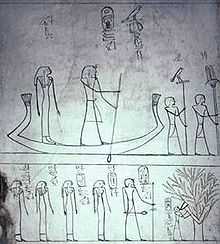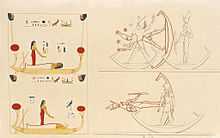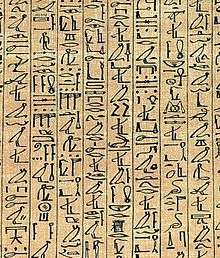
Egyptian hieroglyphs
Egyptian hieroglyphs were a formal writing system used by the ancient Egyptians that combined logographic and alphabetic elements.
Hieroglyph Evolution Data
Looking at some of the ancient objects found at for instance Hierakonpolis it may be interesting to find examples of the oldest form of hieroglyphs and see how they are used. We are looking at examples of interest in relationship to Architecture.
Note: this is not meant to be a complete list of hieroglyphs, please refer to the Resources link at the bottom for sites that offer more.
Format
Please list the following:
- Name,
- Date,
- notation,
- known meaning,
- if made into an object like the Ankh and size.
Ankh
I'm not entirely sure but the falcon on top of the serekh often seems to hold something in one of its claws. Sometimes it looks like an ankh, sometimes it looks more line a twig. In this example it looks more like an ankh. This artefact is a vessel fragment with the name of king Aha (first dynasty). The other image shows a similar scene but here the bird (falcon) does not seem to be grabbing an ankh, but some other object.
Egyptologists do not have a commonly agreed upon theory about the origins of the ankh. Over the years several theories have been put forth. Below is a list of some of the proposed origins of the ankh:
- A union of the male and female. (Thoman Inman, 1869)
- The belt buckle of the mother goddess Isis. Similar to the Tyet symbol (also known as the Isis Knot). (Sir Wallis Budge, and later Westendorf)
- A sandal strap where the loop is the part wrapping around the ankle. (Sir Alan Gardiner)
- The sun crowning over the horizon.
- The path of the sun from east to west (with the loop representing the Nile)
- A stylized person
- A combination of the male and female symbols of Osiris (the cross) and Isis (the oval) respectively, and therefore signifies the union of heaven and Earth.
See w:Ankh
- Nicholas Buccalo's interpretation of the ankh: A representation of the River Nile, in one point perspective, the two horizontal splayed arms, converging onto the center vanishing point, sometimes shown split into a upper half and lower half, are the shores above and reflection below of the land of Egypt. Below the arms is the River Nile which is 'blank' like the sky above the arms. The arc above the arms is the path of the Sun. Springing from the center which represents the vanishing point and hence from the most distant part of the depiction, or at the distant horizon, it's path rises on the right as it skirts across the arms before it arcs to the path of the setting Sun on the left. Note that is does not spring from the arm itself, as that would make the sun rise and set in the foreground. This unique up-side-down tear drop echos the path one would observe standing on a boat in the middle of the Nile. The vertical part(s) below the horizontal arms (early examples show two separate lines) either echos the reflection of the sun path above the arms onto the water, or represents the sun's path during the night. The ankh is represented looking North, echoing the flow of the Nile, especially that of the inundation and allowing the Sun to illuminate the land. It is these three components, the sun, the water and the land, that are represented here to be a embodiment of Egypt itself and thus, to hold the 'life force' of Egypt. This theory is consistent with the visual history of Ancient Egypt, as reflected with hieroglyphs. It is consistent with the importance that the Nile had on life in Egypt, and reinforces the 'Key of the Nile' notion. Early depictions could also have embedded the hieroglyph for horizon at the center of the Ankh, but additional examples are needed. Other depictions (1) show a cartouche and sun disk below the arms on the lower vertical path, perhaps to denote a deceased individual important to AE life. That particular example suggests that the lower vertical arms might represent the sun's path at night, but the particular shape of this part, especially the way it 'reflects' the path of the Sun above the arms, strongly suggests that it is a reflection. Pharaohs are show to carry the Ankh, to show their embedded connection to the land of Egypt to the people. Others are shown being washed with Ankh's pouring out of vessels, to denote that this individual now represents the land of Egypt, is the one connected with the gods of Egypt and thus can communicate with the gods regarding it's fertile health and well being. It is important to note the shape of the 'sun path' as it is more of an oval than a semi-circle and that the portion which springs from the horizon is more linear in form than the upper part, reflecting our perception of the sun as it rises over the horizon in that the sun appears to be traveling in a diagonal direction, and, during mid-day, more arced as it passes overhead connecting it's path to the setting sun's path which echoes the more linear arc of the rising sun. And one should note how at the spring point itself the start of the 'path' is commonly depicted as a point which splays outward to the full width of the path and as such might represent the partial sun as it rises over the horizon and makes itself known to the earth. --NBuccalo 01:56, 2 March 2009 (UTC)
While there are several interpretations of the Ankh, one has to come to terms with what the truth might be. Of these interpretations (associations to the sandal strap, umbilical cord, sun, nile, stars, etc.), one is confronted with an obvious representation of how humans create associations that most likely echo the fundamental meaning of the 'original Ankh'. One might consider some these as being part of the fundamental meaning of the Ankh: 'life giving', representative of the birth/death cycle, 'eternal life', symbol of Egypt and/or the Nile. As in our modern culture, there is a constant evolution of noteworthy things. Considering how people must of passed on knowledge in Ancient Egypt, it shouldn't be surprising when the form, meaning and association evolve into something very different than what the original intent was, and, if the Ankh was considered part of a royal artifact, one can only conjecture how the general public might of wanted to incorporate it into their own social meanings, much like today where the Ankh is considered a symbol of a woman's power, which one could believe was a result in the changing social standing of women in our Western Culture. Given this probability of change, one has to question the validity of many of the theories surrounding the Anhk, one that follows relating the Ankh to the umbilical cord, or the Ankh to the path of the stars, both which visually have only tentative connections at best, but which also have an underlying association which gives them credibility. And in the case of the sandal strap, one must agree that visually it does seem connected by looking at any underlying association and meaning the probability of the Ankh as being a sandal strap seems less likely, even if adopted by the masses at some point in the history and development of the Ankh. --NBuccalo 19:53, 27 September 2009 (UTC)
- Winfred Blackman observed the following in the rural areas of Upper-Egypte in ca 1925. In her book ‘The Fellahin of Upper Egypt’ she writes p. 64: ‘Others [mothers of newborns] – and this is a very common traditions – take a piece of the umbilical cord and sow it into a piece of cotton; this is then hung around the neck of the child with a piece of cord.” On p. 79 there's a picture of such an umbilical cord wrapped in cotton, both ends tied together so that a circle is formed and so that this could even be worn around the neck of the child. Considering the meaning of the word ankh, life, and this afore mentioned tradition that may reach back to Pharaonic times, it would not surprise me if the ankh represented the umbilical cord that would have originally been hung around the child's neck or waist to protect it and give it further life. (Idea originally communicated by Phillipe G., owner of the Dutch forum pr kmt and translated here.)
(1) From Oriental Institute: Margaret Schroeder; Photo Services Oriental Institute Museum Office; University of Chicago.
This ankh is (registration number) OIM E 8356. According to our registration card:
- It was excavated under Theodore M. Davis, in 1903, at Biban el-Moluk, from the Tomb of Thutmose IV (Dynasty 18)
- It is a "blue glazed frit amulet, Ankh sign, with cartouche of Men-kheperw-R', just below the center on straight bar. Purple glaze linear decoration. Mended from five pieces. 228 mm high."
- It has been published in Carter and Newberry: Tomb of Thutmose IV, page 104, #46356 (2).
C-Series: Anthropomorphic Deities
C4 & C5: Khnum
"Khnum (Khenmew, Khnemu, Khenmu, Chnum), from the Egyptian 'unite', 'join' or 'build', was an ancient deity of fertility, water and the great potter who created children and their ka at their conception.... inundation and silt. Sometimes he was shown with four ram heads, aligning him with the sun god Re, the air god Shu, the earth god Geb and Osiris, lord of the dead. In his four headed form, he was known as Sheft-hat."
Source: Tour Egypt: Khnum, Potter God of the Inundation Silt and Creation by Caroline Seawright
D-Series: Parts of the body
D24 & D25; edge, lip; both lips
Note that another depiction shows 2 arc'd lines filled with segments, not as shown here
D28 & D29
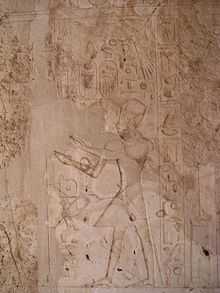
Tuthmosis offering at Karnak

Statue of Hor Auibre from the 13th dynasty
D28 is a logogram representing the Ka. It could also be used as a determinant for the Ka. D29 is purely a logogram used to represent the Divine Ka. The direction and precise position of the arms is not known. Some have seen D28 as representing an embrace, while others see it as a gesture of praise or even defensive in nature.
The ka represents a soul or spirit and was part of any human being. In some depictions the ka was created right along with the person by the god Khnum on his potter's weel.
The term ka also appears in the ancient name for the city Memphis (or at least its great temple): Hut-ka-Ptah which means "House of the ka of Ptah". [1]
D34 & D34a
Arms holding a shield and an axe. This is a logogram meaning to fight (`h3).
means to fight.
D37, D39; derep
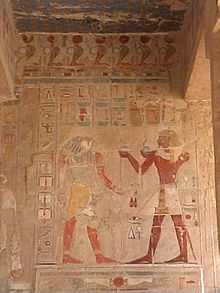
Tuthmosis III shown offering. This gesture is shown in D39.
D37 and D39 was a determinant meaning to offer. D37 shows an arm and hand offering a stylized loaf of bread. D39 shows an arm and hand with an offering jar. [1] (there are many styles of jars)
D40; der
Arm with "stick of power"
D40 is der, or ṭer, "to destroy", for example "remit a tax"
or
D50 and D50a
One finger represented the number 10,000. Two fingers stood for accurate or precise.
I-Series: Amphibious Animals, Reptiles, etc.
I9, I10 and I11:
The first glyph is a horned adder and is used to reresent the letter f. It means he, him or his in some constructions. His son would be written as:
I10 and I11 depict cobras and represent D and DD respectively. The word for eternity is Dt
I12 and I13
These cobras represent the uraeus and Buto respectively.
The Nebty name of a Pharaoh is always listed with the G16 glyph whiuch seems to contain I13 as a component:
Nekhbet, the vulture goddess, represents Upper Egypt and Wadjet, the cobra goddess represents Lower Egypt.
I14 and I15
M-Series: Trees and Plants
M3: Branch; khet
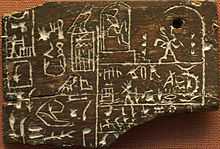
Ebony Label(tag) of possession of King Den
w:Den (pharaoh).
(Note: Size variation of some hieroglyphs: "Lion-forepart"-
and "branch")
Phonetic value khet (from "khet", wood).[2] A determinative for objects made-of or related to wood.
M4: "Year"-symbol—bald palm panicle
M4: Pronounced renpet. From w:Palermo Stone time.
N-Series: Sky, Earth & Water
N1: Sky; Heaven
Pronounced pet the sky hieroglyph represents the heavens. This glyph was sometimes decorated with stars. The sky goddess Nut was sometimes depicted in a pose that reminds us of the sky sign[1].
N2 and N3: Night, Darkness
Both N2 and N3 could be used as logograms or determinants representing night or darkness.
N5 and N6: Sun
In some depictions the sun disk is shown with a uraeus on both sides. In the depictions of the sun disk as the Aten, the disk with its rays often has a uraeus depicted attached to the bottom center of the disk. The disk is related to the worship of Horus, Re, and later Amun-Re. [1] They could both be used as a logogram or a determinant. N5 may have had a slightly broader meaning. Its meaning may have included time, day, hour, and to rise.
N7: "The course of a day"
An abbreviation of the word "the course of the day"
N8: Sunshine, to shine; "The people of the Sun"
_(Mus%C3%A9e_du_Caire)_(2076972086).jpg)
the Aten shown above Akhenaten and Nefertiti
The Aten was the sun god depicted as a solar disk.
The N8 hieroglyph is closely related to N5 and N6. They all represent the sun. [1]
N14: Star
The star is sometimes known as seba. Stars played an important role in the development of the Egyptian calendar. The image of the five pointed star appears on ceilings of tombs and temples. There are for instance examples of the goddess Nut depicted with a dress covered with stars. The goddess Seshat's symbol involved a star. [1]
N14 could also stand for dwa (dua). It was part of the title duat netjer, which is often translated as divide adoratrix and referred to a priestess of Amun.
N16, N17 : Land, Earth, Eternity
(Lord (of the) Two Lands)
Phonetically: ta. These glyphs represent land, earth and eternity. One of the main titles of the king was
Lord of the Two Lands which was
neb tawy in egyptian. The hieroglyphics were a basket (for Neb)
and usually two copies of N17 (or N16) to represent the Two Lands (
tawy) - i.e. Upper and Lower Egypt. The female version of the title
Nebettawy was written almost the same, except for an extra breadloaf
, pronounced
t, to indicate a female form.
N18: Island, Horizon, Desert
N20: Sandbank
Phonetically stands for Wedjeb or Udjeb (wDb) and is the determinant for the term sandbank.
N22: Sandbag, Land, Field
Determinant for sandbag, land or field.
N25: Foreign Land, Desert, Desert Land, "Land of Retjen"
Determinant and logogram representing foreign land, desert and desert land. The title of the King's Son of Kush (Viceroy) was for instance written sa nsw n Ksh
, where Kush is written with the N25 determinant.
N26: Mountain
Phonetically N26 stands for Dju (Dw) and it represents a logogram of a mountain.
N27: Horizon, Akhet

Double cartouche of the names of the Aten showing 3 references to the horizon.
N27 is a logogram representing the horizon. The horizon appears in the official names of the sungod Aten.
and
The second version being a later form of the name of the Aten, representing the elimination of names of old deities.
Interesting is that in the name of Khufu's pyramid Akhet is written "phonetically":
The bird is a crested ibis and represents the idea of spirit. Here akhet is formed by the glyphs for the crested ibis, the horizon, and the bread loaf (making it a female word?). The natural question would be: does this akhet represent the same idea as the akhet represented by the sun disk emerging from a hill? [3]
N28: Crown, Hill of the Sunrise

Cartouches of Ramesses II in Luxor, with the title Son of Re, Lord of Crowns.
("Lord of Risings")
One of the standard titles of the pharaoh was "sa Re neb khau" which is sometimes translated to "Son of Re, Lord of Horizons"
I have also seen it translated as "Lord of Crowns" or "Lord of Diadems"
N29: Hill
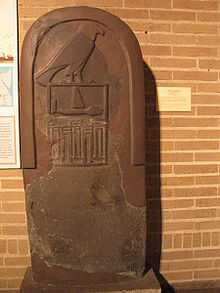
Stela of Qa'a - 1st dynasty
Phonetically represents q. Determinant and logogram of hill.
N30: Hill of Earth
N35 and N35A: Water
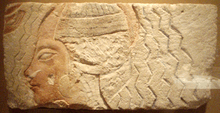
Queen Kiya in purification scene
The water glyph is a common hieroglyph found in texts. In the scene shown here - usually attributed to Queen Kiya, the secondary wife of Pharaoh Akhenaten - the royal lady is shown in a purification scene with water poured over her head.
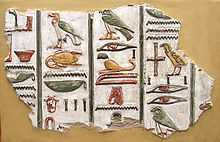
Hieroglyphs from the tomb of Seti I - 19th dynasty - ca 1300 BC
N36: Canal, to love, Nile, river, lake
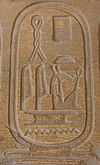
Full name of Sety I: Sety-Merenptah. ca 1300 BC
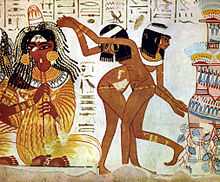
Thebes ca 1400 BC
The canal glyphs could stand phonetically for "mer" (beloved of). Sety's name translates to "Sety beloved of Ptah".
In the scene with the musiscian and the three dancing girls from Thebes three "mer" signs appear as part of the inscription in the center.
N39: Pool; N38: (sloped)-Pool; N37: (also "pool-shape")
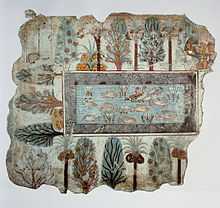
Pond depicted in the tomb of Nebamun
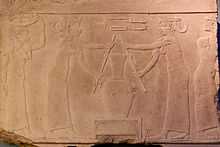
Making Lily perfume. 4th dynasty
The garden scene from a tomb in Thebes (maybe 1400 BC) shows a pond with flowers and animals.
In the perfume making scene a depiction of a pool is shown above the vat, but there are no water waves indicated (rectangle, pool-shape).
O: Buildings and Parts of Buildings
O4 & O5, reed shelter
O4 has the phonetic value h. O5 is used in a wide variety of terms.
1. means to descend (ha(i)); 2. means to send (hab); 3. means day, daytime (heru); 4 means jubilation (henu). [3]
O6 & O7, manor & street
_(Vall%C3%A9e_des_Rois_Th%C3%A8bes_ouest)_-2.jpg)
Horemheb before Hathor. ca 1320 BC

The goddess Nephthys depicted on a sarcophagus
The name of Hathor actually reads hwt-hor Which means something like "House of Horus". The hieroglyph is the house glyph with Horus as a falcon depicted inside the house.
Nephthys's name is written as a house (manor) with the hieroglyph neb (the basket) on top and a bread glyph to give the female ending. Her name in Egyptian then is nebet-hwt "lady of the manor".
O18: the upper egyptian shrine; per-wer or kar
O20: the lower egyptian shrine; Per-nu

From Sahure's mortuary temple in Abusir
O23: Jubilee Pavilion; sed
O24 & N25: pyramid (Memphis), obelisk
The O24 hieroglyph is used as a determinant in the names of the pyramids.
O26: stele
O27: hypostyle hall
O28: pillar
O31: Door; aa & O32: gateway, door
O33: Palace Wall; serekh
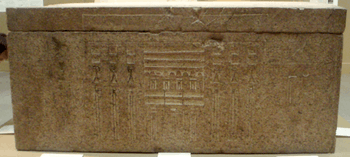
Palace facade on the sarcophagus of Meresankh II (Dyn 4)
O36: wall, enclosure
like the perimeter wall?
O39: (short)-block
various size blocks of stone[2].
O40 and O41: Stairways
P: Ships and parts of Ships
P2: Sailing ship
P3: Barque; wia
P5: Sail; hetau
R-Series, Sacred Emblems
R4: Originally gameboard & gamepiece; later, Mat w/ Loaf of Bread
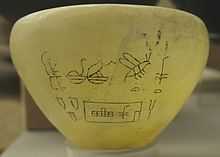
Pharaoh-(King) Semerkhet Vase, from 1st Dynasty, c. 2920 BC. Shows original use as gaming board (with winning) surviving
Gamepiece—w:Game piece (hieroglyph).
(The translation is at
w:Semerkhet.)
Phonetic value htp, (hotep); for content, peace, satisfied, (happy, etc.). Many pharaohs used "Hotep" as part of their name: ex: Amenhotep: for "Amun is Complete", or "(The) Peace of Amun", "Satisfier (of) Amun" (etc.).
R8: Ntr (god); R9: Natron; R10: necropolis: Sail
R12: Insignia-Carrier, iat-Support (a "standard")
and R13 (support with Hawk & Feather)

Predynastic (late 4th millennium BC)
w:Bull Palette, with 3 different styles of Insignia-Carrier; the third one carries the symbol for the
"Thunderbolt of Min"-(God Min)(R23)
Predynastic and Narmer Palettes. The w:cosmetic palettes have some of the first uses of hieroglyphs, with the Narmer Palette probably culminating the timeperiod.
Originally, the beginning cosmetic palettes were 'rough', 'crude', in a rhomboidal-shape, unadorned, but later incorporated with a powder mixing circle, and highly thematic, including animal-shaped (w:zoomorphic palettes.
R20: Goddess Seshat's Emblem
and R21 (archaic form)

Luxor Temple
Goddess Seshat, from the Old Kingdom, can be seen on the w:Palermo Stone: "creation of a statue to Goddess Seshat and Mafdet", from Palermo piece, at Palermo Museum (confer with article w:Den (pharaoh)).
S: Crowns, Dress, Staves, etc.
S-20: Seal
and S19 (later (curved-cording-Seal)
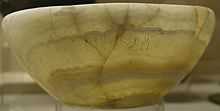
Alabaster vase of 1st Kingdom Hemaka, under Pharaoh Den.

Curved-cord Seal.
Alabaster vase of 1st Kingdom: "Seal-bearer-(of the)-King, H-ma-ka" (w:Hemaka). 2nd photo of later style Seal, with curved cord.
S24: Knot

Knot as belt insignia.
The "reef knot" is often found on belt buckles. Ideogram in ṯst (tjst) for "knot", "vertebra", or similar words.[2]
T: Warfare, Hunting, Butchery
T26: Bird Trap (or Bird-Cage-Carrier)
and T27 (Old Kingdom style)
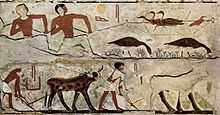
Old Kingdom style: also shows the actual "netting of the birds".
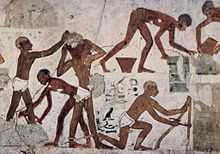
Regular style (?).
A scene from Ptahhotep's tomb, 5th Dynasty shows the hieroglyph
, as well as a 'carrier-attendant' with pole, and a bird "trap" (cage) on each end. (Old Kingdom style hieroglyph)[4]
U-Series, Agriculture, Crafts, and Professions
U25: (vertical) Hand "Lathe" (=Drill)

2-opposing Stone-weights, an offset handle, and a cutting-tool tip at shaft's end; used for drilling holes into stone, typically small unguent bowls, or larger ceremonial bowls.
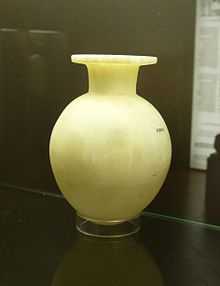
Probable "drilled" unguent container.
2-opposing Stone-weights, an offset handle, and a cutting-tool tip at shaft's end; used for drilling holes into stone, typically small unguent bowls, or larger ceremonial bowls.
Examples of "sets" of zoomorphic bowls are known from the Old Kingdom time. First drilled, then the outside of the bowl turned into an animal figure.
V-Series, Rope, fiber, baskets, bags, etc.
V13: Tethering Rope
V14-(variant)

The famous
w:Narmer Palette.
(approximately 3100 BC)
Note:
Door-(vertical) or
Gateway-(O31, which see) is above the decapitated souls. The
soul's-bark is above the 2nd column of prisoners.
Phonetic value Th
The procession leader (behind the 4
–Standard-Bearers) has their name in front of their head:
using the female determinative
, unless the person's name is
Thet.
W: Vessels of Stone and Earthenware
W21: 2-Wine-Jugs

Queen Nefertiabet (Nefer-t-Ab-t)(Beauty-East)...("The Eastern Beauty"), a
w:Slab stela.
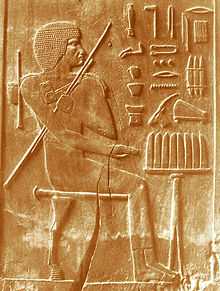
Wood panel from Protodynastic Period, 3rd Dyn. of
w:Hesy-Ra.
2-Wine-Jugs.
W25: Pot w/Legs

Ebony Label(tag) of possession of King Den
w:Den (pharaoh), c. 3000BC.
(Note: Size variation of some hieroglyphs: "Lion-forepart"-
and "branch"-(M3))
Phonetic value an.[2] A determinative for bring, brought, etc. The middle w:register (sculpture), center-right shows the destruction of an enemy stronghold.
,
with the "walking pot hieroglyph" (at left).
X-Series: Loaves and Cakes
X6:PAt, bread
X8: give
Aa-Series: Unclassified
Aa10, unconfirmed
Note, as drawn elsewhere (see reference below) this is shown as a triangle with the bottom horizontal, shortest side vertical.
ramp/stair in sed-hed court? ramp to access heights, as in for people or to build pyramids? ramp to the heavens?
Aa30: Frieze (ornament)
and Aa31 (older or archaic type, different usage)
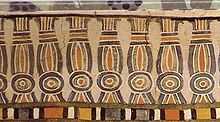
"kheker" painted friezes, Tomb of Sennefer.
"Kheker"-Ornament. Later usage.
See Also
Resources
Gardener's Sign List from Ancient Egypt Online
- 1 2 3 4 5 6 R.H. Wilkinson, Reading Egyptian Art, 1992
- 1 2 3 4 Maria Carmela Betrò, Hieroglyphics, The Writings of Ancient Egypt, c 1995-96, Abbeville Press Publishers, 250pp.
- 1 2 Collier and Manley: How to Read Egyptian hieroglyphs; 1998, University of California Press
- ↑ Schulz, R. and Seidel, M., Eds.: Egypt: The World of the Pharaohs, ; Konemann Verlagsgesellschaft mbH, Cologne, English translation version.
Comments and Questions
Talk: Development of hieroglyphic writing. Or click on discussion tab at the top of the page.

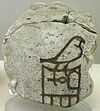





_(Mus%C3%A9e_du_Caire)_(2076972086).jpg)








_(Vall%C3%A9e_des_Rois_Th%C3%A8bes_ouest)_-2.jpg)



_(Vall%C3%A9e_des_Rois_Th%C3%A8bes_ouest)_-6.jpg)
